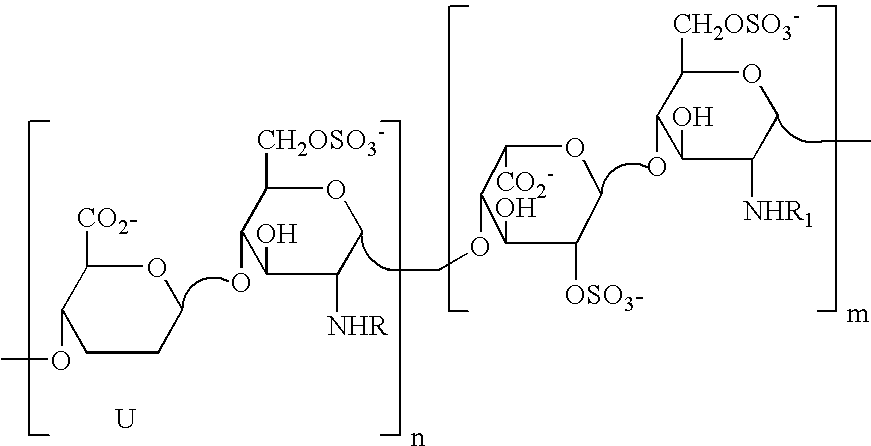Derivatives of partially desulphated glycosaminoglycans endowed with antiangiogenic activity and devoid of anticoagulating effect
a glycosaminoglycan and partially desulphated technology, applied in the direction of antinoxious agents, drug compositions, metabolic disorders, etc., can solve the problems of many aspects still unsolved, defeating or at least limiting this type of pathology, and achieving non-existent anticoagulant properties, avoiding or reducing side effects, and reducing the effect of anticoagulant properties
- Summary
- Abstract
- Description
- Claims
- Application Information
AI Technical Summary
Benefits of technology
Problems solved by technology
Method used
Image
Examples
example 1
[0161]1 g of heparin is dissolved in 12.5 ml of NaOH 1N. The solution is heated and stirred at 60° C. for 45 minutes. The reaction is blocked by rapid cooling and neutralisation. The solution is then heated at 70° C. at pH 7 until the epoxide ring is completely open (the reaction trend is controlled by NMR). The desulfated sample (here called G2999H) is dissolved in 20 ml of water and cooled to 4° C. After the addition of 20 ml of a solution of NaIO4 0.2 M, the solution is left to stir in the dark for 20 hours, and the reaction is stopped by adding ethylene glycol and the salts are eliminated by tangential ultrafiltration. 400 mg of NaBH4, subdivided into several portions, are added to the desalted solution (30-40 ml). The solution is left to stir for 3 hours at ambient temperature, then neutralised with diluted HCl and desalted by tangential ultrafiltration. 710 mg of product, here called ST1514, are obtained.
[0162] Molecular weight (MW): 11200 D, polydispersion index D 1.3, sulfa...
examples 2-4
[0163] Adopting the same procedure as in example 1, with the exception that the basic solution was heated for 15, 30 and 60 minutes, respectively, compounds with the following characteristics were obtained: [0164] ST1513: molecular weight (MW) 12900 D, polydispersion index D 1.5, sulfation degree 2.05 (expressed as SO3—:COO— molar ratio), percentage of modified uronic acids compared to total uronic acids: 5% epoxide groups, 29% oxidated and reduced (split) uronic residues; [0165] ST1516: molecular weight (MW) 12900 D, polydispersion index D 1.5, sulfation degree 1.8 (expressed as SO3—:COO— molar ratio), percentage of modified uronic acids compared to total uronic acids: 5% epoxide groups, 29% oxidated and reduced (split) uronic residues; [0166] ST1515: molecular weight (MW) 9200 D, polydispersion index D 1.5, percentage of modified uronic acids compared to total uronic acids: 11% epoxide groups, 27.5% oxidated and reduced (split) uronic residues.
example 5
Glycol-split N-acetyl heparins (NA-Hgs)
[0167] Fully N-acetylated heparin (100NA-H,) was prepared from H (Heparin) as described. (Inohue, Y., Nagasawa, K. Selective N-desulfation of heparin with dimethylsulphoxide containing water or methanol. Carbohydr. Res. 1976, 46, 87-95.) 50% N-acetyl-heparin (50NA-H,) was prepared by solvolytic partial N-desulfation of H in DMSO / MeOH (9 / 1, v / v) (Nagasawa, K.; Inoue, Y.; Kamata, T. Solvolytic desulfation of glycosaminoglycuronan sulfates with dimethyl sulphoxide containing water or methanol. Carbohydr. Res. 1977, 58, 47-55.) for 120 min at 20° C., followed by N-acetylation with acetic anhydride in alkaline medium. (Inohue, Y., Nagasawa, K. Selective N-desulfation of heparin with dimethylsulphoxide containing water or methanol. Carbohydr. Res. 1976, 46, 87-95.) The N-acetylation degree was determined by integration of 13C NMR signals at 60 and 55 ppm corresponding to the C-2 of GlcNSO3 and GlcNAc, respectively. The glycol-split derivative of 50N...
PUM
 Login to View More
Login to View More Abstract
Description
Claims
Application Information
 Login to View More
Login to View More - R&D
- Intellectual Property
- Life Sciences
- Materials
- Tech Scout
- Unparalleled Data Quality
- Higher Quality Content
- 60% Fewer Hallucinations
Browse by: Latest US Patents, China's latest patents, Technical Efficacy Thesaurus, Application Domain, Technology Topic, Popular Technical Reports.
© 2025 PatSnap. All rights reserved.Legal|Privacy policy|Modern Slavery Act Transparency Statement|Sitemap|About US| Contact US: help@patsnap.com



